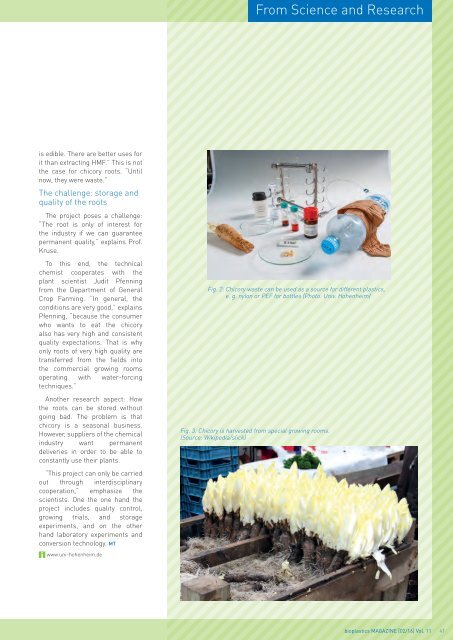Issue 02/2016
bioplasticsMAGAZINE_1602
bioplasticsMAGAZINE_1602
Create successful ePaper yourself
Turn your PDF publications into a flip-book with our unique Google optimized e-Paper software.
From Science and Research<br />
is edible. There are better uses for<br />
it than extracting HMF.” This is not<br />
the case for chicory roots. “Until<br />
now, they were waste.”<br />
The challenge: storage and<br />
quality of the roots<br />
The project poses a challenge:<br />
“The root is only of interest for<br />
the industry if we can guarantee<br />
permanent quality,” explains Prof.<br />
Kruse.<br />
To this end, the technical<br />
chemist cooperates with the<br />
plant scientist Judit Pfenning<br />
from the Department of General<br />
Crop Farming. “In general, the<br />
conditions are very good,” explains<br />
Pfenning, “because the consumer<br />
who wants to eat the chicory<br />
also has very high and consistent<br />
quality expectations. That is why<br />
only roots of very high quality are<br />
transferred from the fields into<br />
the commercial growing rooms<br />
operating with water-forcing<br />
techniques.”<br />
Another research aspect: How<br />
the roots can be stored without<br />
going bad. The problem is that<br />
chicory is a seasonal business.<br />
However, suppliers of the chemical<br />
industry want permanent<br />
deliveries in order to be able to<br />
constantly use their plants.<br />
“This project can only be carried<br />
out through interdisciplinary<br />
cooperation,” emphasize the<br />
scientists. One the one hand the<br />
project includes quality control,<br />
growing trials, and storage<br />
experiments, and on the other<br />
hand laboratory experiments and<br />
conversion technology. MT<br />
www.uni-hohenheim.de<br />
Fig. 2: Chicory waste can be used as a source for different plastics,<br />
e. g. nylon or PEF for bottles (Photo: Univ. Hohenheim)<br />
Fig. 3: Chicory is harvested from special growing rooms.<br />
(Source: Wikipedia/slick)<br />
bioplastics MAGAZINE [<strong>02</strong>/16] Vol. 11 41


















